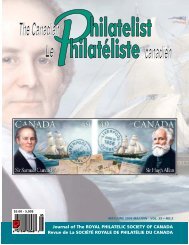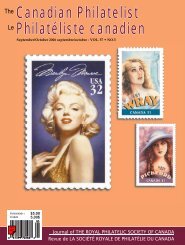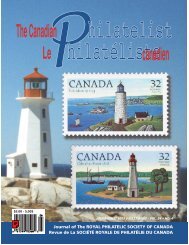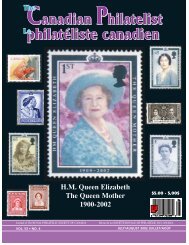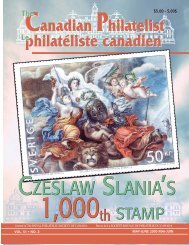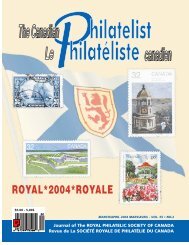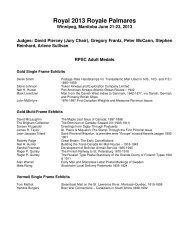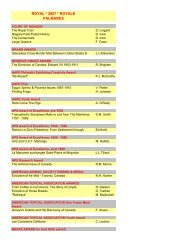Phil pages July-Aug-Final - The Royal Philatelic Society of Canada
Phil pages July-Aug-Final - The Royal Philatelic Society of Canada
Phil pages July-Aug-Final - The Royal Philatelic Society of Canada
Create successful ePaper yourself
Turn your PDF publications into a flip-book with our unique Google optimized e-Paper software.
<strong>The</strong> Algonkian Indian eight-cent variety showing skip.<br />
perforates stamps in the form <strong>of</strong> a T or<br />
upside down T compared to an H-comb<br />
which perforates half <strong>of</strong> the stamp in the<br />
row below and half <strong>of</strong> the stamp in the<br />
row above (or half in the initial column<br />
and half in the next column).<br />
As in the above case, this variety is<br />
also informative. First, as mentioned it<br />
tells us that a T-comb perforator was<br />
used. Second, the stamps were perforated<br />
not from top to bottom or bottom to top<br />
but sidewards, in other words from left to<br />
right. Third, since the elongated stamps<br />
contain part <strong>of</strong> the design <strong>of</strong> the next<br />
stamp, the skip occurred in the middle <strong>of</strong><br />
the sheet and not at the end.<br />
Unlike the Parliament Tower 14-cent<br />
stamp variety, there is no correction <strong>of</strong><br />
the skip in the next stamp. Had there been<br />
a correction, the fourth column <strong>of</strong> stamps<br />
would have been narrower and there<br />
would have been overlapping perforations<br />
in the corners <strong>of</strong> the stamp in the<br />
last column on the left. <strong>The</strong>se overlapping<br />
perforations would have been visible<br />
on the white strip between the fourth<br />
and fifth columns unless it was a 2-row<br />
T-comb perforator. In this case, the overlapping<br />
perforations would have been<br />
visible on the white strip between a fifth<br />
column and selvage.<br />
Conclusion<br />
<strong>The</strong> above few examples provide philatelists<br />
with how stamp collecting can be<br />
educational and more than just a hobby.<br />
<strong>The</strong>re are numerous other examples such<br />
as misaligned perforations, little, large,<br />
double and elongated perforations, blind<br />
perforations, freak strikes <strong>of</strong> the perforator<br />
which provide other types <strong>of</strong> educational<br />
information. Some <strong>of</strong> these examples are<br />
not only educational but in the longrun<br />
will enable philatelists to form a better<br />
understanding about stamps and help<br />
them avoid costly errors. A good example<br />
<strong>of</strong> the latter is the case <strong>of</strong> double perforations<br />
on coil stamps which were fakes.<br />
Bibliography<br />
1. Monteiro, Joseph, Printing and<br />
Perforating Errors <strong>of</strong> Postage Stamps<br />
in <strong>Canada</strong> (1953-1997) – An Analysis,<br />
1998.<br />
2. John H. Talman Auctions, Sales Nos.<br />
208-209, Wednesday, Jan. 26, 2000,<br />
Lot 523, 2000.<br />
3. Saskatoon Stamp Centre, Catalogue<br />
#192, p. 43.<br />
4. Saskatoon Stamp Centre, Catalogue<br />
#203, p. 27.<br />
5. Beaudet, Leopold, “Canadian Stamp<br />
Varieties – 5,” <strong>The</strong> Canadian<br />
<strong>Phil</strong>atelist, Volume 32, Number 4,<br />
<strong>July</strong>-<strong>Aug</strong>ust 1981, p. 247.<br />
6. Jamieson, John and Beaudet, Leopold,<br />
Fake Double Perf Coils Uncovered,<br />
Corgi Times, Volume V, Number 6,<br />
May-June 1997, pp.109-118.<br />
A Number <strong>of</strong> New Major Errors<br />
Have Appeared in<br />
Auction Catalogues<br />
During the last few months, a number<br />
<strong>of</strong> major errors were reported in several<br />
auction catalogues. It was the first time<br />
that I had seen these errors and for the<br />
benefit <strong>of</strong> fellow philatelists I shall indicate<br />
these discoveries with appropriate<br />
illustrations where possible.<br />
E. Pauline Johnson<br />
five-cent stamp errors<br />
Two major errors were reported on<br />
the 5-cent E. Pauline Johnson stamp<br />
issued on March 10, 1961. This stamp<br />
was printed in light green and red and<br />
perforated with a 12x12 perforation<br />
gauge. <strong>The</strong> gum used on this stamp was<br />
the yellow Arabic gum. This stamp was<br />
issued to celebrate the 100th<br />
Anniversary <strong>of</strong> the birth <strong>of</strong> Pauline<br />
Johnson. If l recall correctly, she was an<br />
immigrant from England who attempted<br />
to teach the Native Indians English and<br />
later married a Indian Mohawk chief.<br />
Type-1<br />
Missing Colour<br />
and Imperforate<br />
Type 2<br />
Imperforate<br />
Two major errors were reported on this<br />
stamp.<br />
<strong>The</strong> first appeared in Ian Kimmerly’s<br />
Auction catalogue in <strong>Aug</strong>ust 1999. This<br />
error is interesting in that it contains two<br />
types <strong>of</strong> errors. First, the red engraving is<br />
missing. Second, the pair <strong>of</strong> stamps<br />
<strong>of</strong>fered for sale were fully imperforate.<br />
<strong>The</strong> above mentioned catalogue notes<br />
that the pair <strong>of</strong> stamps is unique. This can<br />
be seen in the illustration <strong>of</strong> the stamps<br />
(Type 1) shown above.<br />
<strong>The</strong> second major error was reported<br />
in R. Maresch & Son’s auction catalogue<br />
<strong>of</strong> January 18, 2000. This error unlike the<br />
above error contains only one type <strong>of</strong><br />
error. It is a fully imperforate error. An<br />
illustration <strong>of</strong> it is also shown above<br />
(Type 2).<br />
Charter <strong>of</strong> Rights<br />
36-cent stamp error<br />
A major error on the Charter <strong>of</strong> Rights<br />
36-cent stamp was recently <strong>of</strong>fered for<br />
sale. This stamp honours the Canadian<br />
Charter <strong>of</strong> Rights and Freedoms. It was<br />
issued to celebrate the 5th Anniversary <strong>of</strong><br />
Canadian Charter <strong>of</strong> Rights and<br />
Freedoms on April 15, 1987. <strong>The</strong><br />
Canadian Charter <strong>of</strong> Rights is now part <strong>of</strong><br />
a famous piece <strong>of</strong> legislation and is one<br />
<strong>of</strong> the major achievements <strong>of</strong> the former<br />
Prime Minister Pierre Trudeau. It was the<br />
most important feature <strong>of</strong> the new<br />
Constitution which became <strong>Canada</strong>’s<br />
supreme law in April 1982. <strong>The</strong> stamp<br />
issued to commemorate this aspect <strong>of</strong><br />
Canadian history was perforated with a<br />
perforation gauge <strong>of</strong> 14 by 13.5 and the<br />
gum used on these stamps was PVA, a<br />
gum used on present day stamps.<br />
This error was reported in the Eastern<br />
Auctions Ltd. catalogue <strong>of</strong> January 2000.<br />
Le philatéliste canadien / <strong>The</strong> Canadian <strong>Phil</strong>atelist Juillet - Août 2000 / 155



